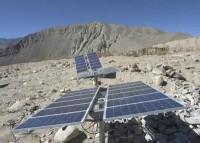By David Evans, the Australian
I devoted six years to carbon accounting, building models for the Australian Greenhouse Office. I am the rocket scientist who wrote the carbon accounting model (FullCAM) that measures Australia’s compliance with the Kyoto Protocol, in the land use change and forestry sector. FullCAM models carbon flows in plants, mulch, debris, soils and agricultural products, using inputs such as climate data, plant physiology and satellite data. I’ve been following the global warming debate closely for years.
When I started that job in 1999 the evidence that carbon emissions caused global warming seemed pretty good: CO2 is a greenhouse gas, the old ice core data, no other suspects. The evidence was not conclusive, but why wait until we were certain when it appeared we needed to act quickly? Soon government and the scientific community were working together and lots of science research jobs were created. We scientists had political support, the ear of government, big budgets, and we felt fairly important and useful (well, I did anyway). It was great. We were working to save the planet.
But since 1999 new evidence has seriously weakened the case that carbon emissions are the main cause of global warming, and by 2007 the evidence was pretty conclusive that carbon played only a minor role and was not the main cause of the recent global warming. As Lord Keynes famously said, “When the facts change, I change my mind. What do you do, sir?”
There has not been a public debate about the causes of global warming and most of the public and our decision makers are not aware of the most basic salient facts: 1. The greenhouse signature is missing. We have been looking and measuring for years, and cannot find it. Each possible cause of global warming has a different pattern of where in the planet the warming occurs first and the most. The signature of an increased greenhouse effect is a hot spot about 10km up in the atmosphere over the tropics. We have been measuring the atmosphere for decades using radiosondes: weather balloons with thermometers that radio back the temperature as the balloon ascends through the atmosphere. They show no hot spot. Whatsoever. If there is no hot spot then an increased greenhouse effect is not the cause of global warming. So we know for sure that carbon emissions are not a significant cause of the global warming. If we had found the greenhouse signature then I would be an alarmist again. When the signature was found to be missing in 2007 (after the latest IPCC report), alarmists objected that maybe the readings of the radiosonde thermometers might not be accurate and maybe the hot spot was there but had gone undetected. Yet hundreds of radiosondes have given the same answer, so statistically it is not possible that they missed the hot spot. Recently the alarmists have suggested we ignore the radiosonde thermometers, but instead take the radiosonde wind measurements, apply a theory about wind shear, and run the results through their computers to estimate the temperatures. They then say that the results show that we cannot rule out the presence of a hot spot. If you believe that you’d believe anything.
Dr David Evans was a consultant to the Australian Greenhouse Office from 1999 to 2005.
Read more on why David has come to believe Carbon Doxide is an innocent bystander to natural climate change here.

By John McLean on SPPI
The IPCC is a single-interest organisation, whose charter presumes a widespread human influence on climate, rather than consideration of whether such influence may be negligible or missing altogether. Though the IPCC’s principles also state that a wide range of views is to be sought when selecting lead authors and contributing authors, this rule has been honored more in the breach than in the observance. More than two-thirds of all authors of chapter 9 of the IPCC’s 2007 climate-science assessment are part of a clique whose members have co-authored papers with each other and, we can surmise, very possibly at times acted as peer-reviewers for each other’s work.
Of the 44 contributing authors, more than half have co-authored papers with the lead authors or coordinating lead authors of chapter 9.It is no surprise, therefore, that the majority of scientists who are skeptical of a human influence on climate significant enough to be damaging to the planet were unrepresented in the authorship of chapter 9. Many of the IPCC authors were climate modelers - or associated with laboratories committed to modeling - unwilling to admit that their models are neither accurate nor complete. Still less do they recognize or admit that modeling a chaotic object whose initial state and evolutionary processes are not known to a sufficient precision has a validation skill not significantly different from zero. In short, it cannot be done and has long been proven impossible. The modelers say that the “consensus” among their models is significant: but it is an artifact of ex-post-facto tuning to replicate historical temperatures, of repeated intercomparison studies, and of the authors’ shared belief in the unrealistically high estimate of climate sensitivity upon which all of the models assume.
The relationships between most of the authors of chapter 9 demonstrate a disturbingly tight network of scientists with common research interests and opinions. The contrast between this close-knit group and the IPCC’s stated claim to represent a global diversity of views is remarkable and does not augur well for the impartiality or integrity of chapter 9’s conclusions. Wegman et al identified a similar network of scientists in their notable critique of the now-discredited “hockey stick” 1000-year northern-hemisphere temperature graph by Mann et al. (1998, 1999, corrected 2004) that had featured six times, prominently, in full color and at full scale, in the IPCC’s 2001 assessment report.
The hypothesis of damaging, man-made warming is a long way from being proven - and, given the recent trend in the peer-reviewed literature, is well on the way to being disproven. Recent cooling of the planet further suggests that man-made warming is at best too weak to be detected in the “noise” of natural internal variability. Governments have naively and unwisely accepted the claims of a human influence on global temperatures made by a close-knit clique of a few dozen scientists, many of them climate modellers, as if such claims were representative of the opinion of the wider scientific community. On the evidence presented here, the IPCC’s selection of its chapter authors appears so prejudiced towards a predetermined outcome that it renders its scientific assessment of the climate suspect and its conclusions inappropriate for policy making. Read this full devastating analysis here.
Paul Chesser, Climate Strategies Watch
Renewable portfolio standards that have passed in several states (and promoted by many other state climate commissions) are nothing more than another hidden energy tax (like cap-and-trade). That is no better illustrated than in a Raleigh News & Observer article today, which explains how Progress Energy is about to go to battle with North Carolina’s Utilities Commission in order to raise rates so it can pay for its (state-required 12.5 percent minimum) renewable-sourced energy generation: Progress Energy is ready to start charging customers extra to tap solar power and other renewable resources, but the power company is facing criticism that its proposed charges favor energy hogs.

The two sides will get a hearing today before the N.C. Utilities Commission, which will decide whether the Raleigh-based utility’s request is reasonable. The hearing is the first public debate on how best to pay for the alternative energy that utilities must tap to meet a new state law. Progress wants to charge households 46 cents a month, businesses $2.33 a month and industrial customers $23.38 a month. If approved, the new charges would go into effect in December.
Meanwhile environmental extremists are doing everything they can to kill a new Duke Energy coal-fired power plant that just obtained air quality permits. Unrelenting court battles are their strategy. If renewables are such a great source of power that can replace fossil fuels, why the need to raise monthly electric rates? Why the need for massive subsidies? Oh, that’s right—it’s for all those great new “green” jobs! See more here.


